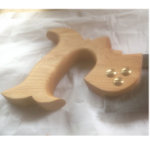Marking Gauges
Welcome! / Forums / General Woodworking Discussions / Tools and Tool Maintenance/Restoration / Marking Gauges
- This topic has 6 replies, 4 voices, and was last updated 10 years, 11 months ago by
Jonathan Skipsey.
-
AuthorPosts
-
Ok I went for the best of both worlds. I prefer the wheel type, but I can also see where the pin type might be the best option. HaHa so I now have both 🙂
The wheel on this gauge is larger than others I have tried, so you can get a nice deep line if needed.
Pleased I only buy tools when there is a Y in the day. 🙂
Attachments:
You must be logged in to view attached files. 17 July 2013 at 11:33 am #14911
17 July 2013 at 11:33 am #14911Interesting. What is it about the wheel type that you find better, and when do you think the pin type would have an advantage?
George.
Most people have to learn how to use a pin gauge, as we can see from resent posts.The pin is more likely to follow the grain and run off. For me I don’t find them all that easy to hold, but thats just me.
Wheel gauge just about anyone can pick one up and use it straight away, it gives my a line right where I want it with no run off, The bevel pulls the gauge into the work, and dose not crush the fibres on soft wood, just a nice crisp line.
I have not tried the pin gauge yet, but I think it would give me a thicker deeper line for laying out mortices. Bottom line I just feel more at ease using the wheel type, just personal preference.
Workshop Heaven Mortice Attachment for Quangsheng Marking Gauge
Converts the single cutter Quangsheng marking gauge into a twin cutter mortice gauge.
The kit contains:
Two stainless steel screws (use the longer one for 9mm and wider mortices)
Ten 1mm brass spacers
An extra 2mm thick cutting wheel
A stainless nut and washer to keep everything together when not in use.With the mortice attachment installed you can mark twin gauge lines up to 14mm apart, although generally in furniture making once you get past 12mm you would switch to twin tenons for greater strength.
The two spacers installed between the first cutter and the stem compensate for the thickness of the cutter, so that the graduations on the stem still read correctly. They also provide a larger bearing surface for the concave side of the cutter to register against.
Attachments:
You must be logged in to view attached files. 2 September 2013 at 11:18 am #17350
2 September 2013 at 11:18 am #17350Brian Close (Darlington College) taught to let the pin drag, and use light pressure, keep the guage moving-even if the pin is in mid air to begin with, do a very light pass, gradually rotate the gauge a little to increase the depth of scribe if necessary. I always liked this method (overhand grip). But you couldnt clearly see the tiny little brad point on the standard issue marples type of gauge. I really liked Paul’s simple modification of simplly putting the pin at a sloping angle. I have made most of my marking gauges with long fences (5 or 6 inches) and captive wedges for adjusting the beam length. So I modified the beam on one of them, to try it out. I used a 2 inch masonary nail, very carefully reground and honed to a long slender taper for the last3/4 inch or so. It needed to be that long to go across the diagonal of my (rather on the chunky side) gauge beam, with a good 3/4 inch sticking out. The fence stays level and in full contact with the board to be scribed, the pin trails in perfect clear view. Basically my gauge became easier and more confidence-giving than it was before…! I intend to do the same with a twin beam marking gauge next….
Cheers Jonathan -
AuthorPosts
- You must be logged in to reply to this topic.
